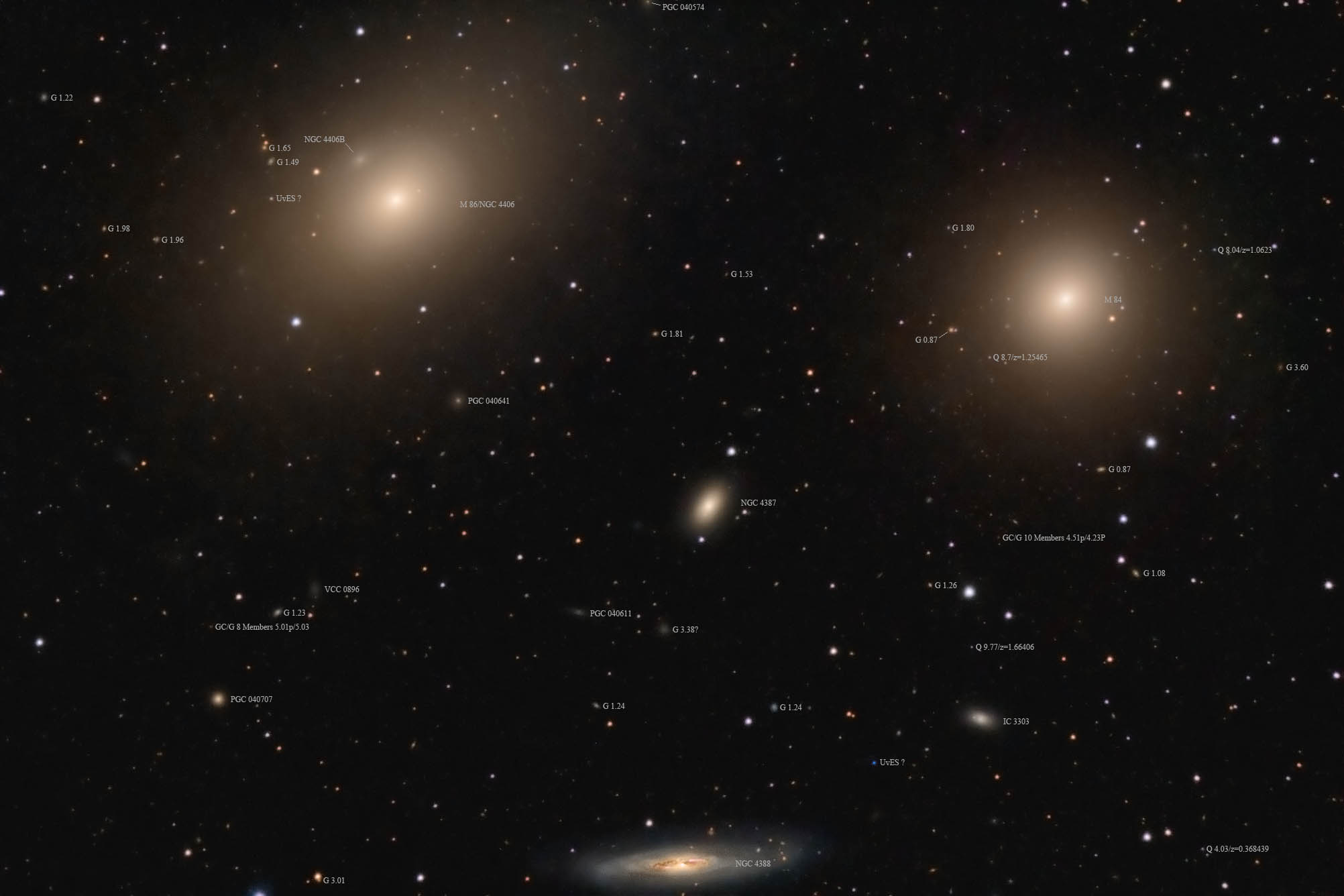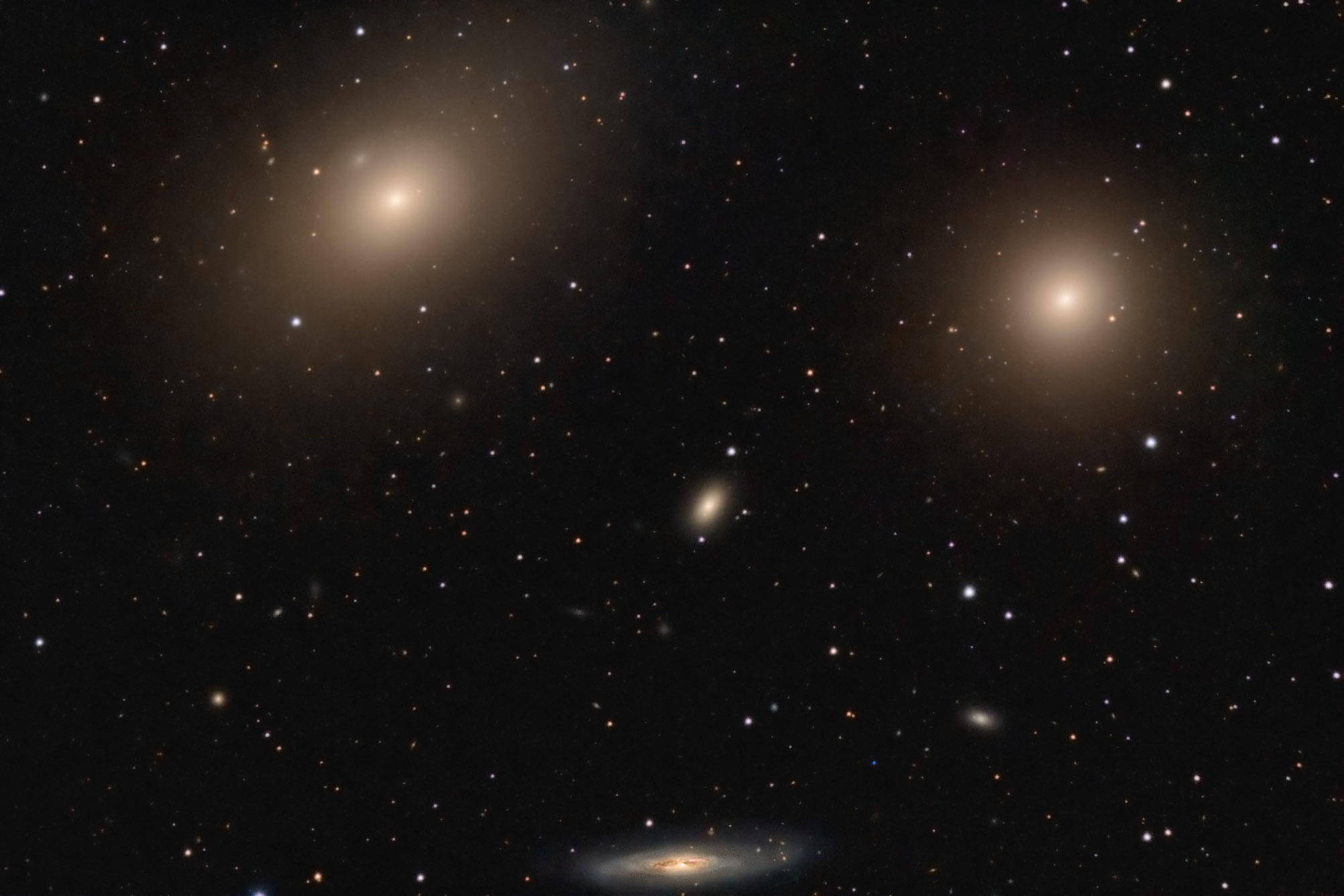Object name: M084Designation(s): M084, M086, NGC4387, NGC4388, NGC4406B, IC3303, M84 and M86 are two major elliptical galaxies near the core of the Virgo Cluster of galaxies. M84 is classed as an E1 galaxy and also as being a Low-Excitation Radio Galaxy (LERG), having a Low-Ionization Nuclear Emission-Line Region (LINER) and being a Seyfert 2 type galaxy. All this means it has a very actively feeding supermassive black hole at its core. A Seyfert galaxy shows this by having emission lines from the core region. A type 1 Seyfert has both narrow and broad emission lines while a type 2, like M84, has only narrow lines, an indication of less activity than a type 1. A galaxy that is only LINER is sometimes called Seyfert 3 adding to the confusion. Then there are type 1.5, 1.8 and 1.9 Seyfert's. You can read more about this at: http://spider.seds.org/spider/ScholarX/seyferts.html
Redshift puts it about 64 million light-years away while Tully Fisher measurements vary widely with a median value of about 56 million light-years. It is said to have several dust lanes but I didn't pick them up. Likely will need a lot more time to see these very low contrast features. My image shows lots of fuzzies to the southeast of the core but still in the fainter outer halo of the galaxy. I thought these might be globular clusters but most turned out to be distant galaxies without redshift data. I found no designated cluster that would cover them in NED, however. I did find a very few globular clusters, mostly to the northwest. They were so faint they are barely seen in the image so I didn't note them on the annotated image. NED also lists over 100 planetary nebulae, none of which were seen in my image that I looked for. With no magnitude listed in NED, I could only sample the listing. The Hubble image of the very core of M84 showing the dust lanes is at: http://upload.wikimedia.org/wikipedia/commons/7/7a/Messier_84_nucleus_Hubble.jpg . NED lists its diameter as about 6 minutes while I measure about 10 on my image with some really deep images showing it even larger. Using 56 million light-years and my measurement of 10 minutes puts it at about 160,000 light-years in diameter.
M86 is a far larger galaxy. NED classifies it as SO(3)/E3 by NED and simply E3 by the NGC project. The galaxies in the Virgo cluster have a wide dispersion as to radial velocity indicating it is a very dynamic cluster. M86, in fact, is blue shifted indicating redshift is meaningless for it and likely other galaxies in the cluster. For this reason, I didn't label the cluster members with a redshift distance estimate as they appeared more like a random number list than a true distance measurement. Several different measurement methods have been used on the galaxy, some based on brightness variations, some on galaxy clusters some on planetary nebula and other methods. They give distances ranging from 40 to 60 million light-years. The median value is about 55 million light-years. With 35 listed in NED, you have plenty to choose from!
It has an X-ray plume which is thought due to the stripping of gas from it by ram pressure due to its high velocity through the cluster. It has surprisingly few globular clusters for such a large galaxy. Again most were far too faint for me to show on the annotated image. It does not seem to be close to M84 except by projection as seen from our spot in space so is not considered interacting with it. There are however hydrogen traces connecting it with one of "The Eyes" galaxies, NGC 4438, Arp 120. This galaxy also is moving through the Virgo cluster and experiencing ram pressure stripping though it has a very small redshift rather than being blue shifted like M86. It lies just outside the left edge of my image.
My measurement of its diameter is at least 15 minutes. Likely larger as the north end extends beyond my frame but NED says only 9 minutes. Again deep images show it larger than I do. Again going with my estimate and the distance of 55 million light-years gives a size of nearly 240,000 light-years. Now that's big!
M84 and M86 were discovered by Johann Koehler on May 5, 1779. Charles Messier found both on March 18, 1781. SEDS coverage: M84 http://messier.seds.org/m/m084.html
M86 http://messier.seds.org/m/m086.html
NGC 4387 near the center of my image is listed as E5 by NED and simply E by the NGC Project. It seems to show hints of structure in my image those papers I saw all say it lacks structure but for its boxy nature. Redshift puts it somewhat too close to be reliable. The median value of 12 measurements in NED put it about 57 million light-years away.
Below NGC 4387 is the faint fuzzy PGC 040577. Its listing in NED is very puzzling hence the question mark in the annotated image. NED shows it as a Group Member. This would indicate it is a member of the Virgo cluster or at least some cluster. The detail says they mean the Virgo Cluster. Its classification is dE2 meaning a dwarf E2 galaxy. Problem is the redshift is z=0.295417 which puts it some 3.38 billion light-years distant. While radial velocities in the Virgo cluster show a high variability this is far beyond that! NED lists its size at 16.2" while I get a bit larger size. Going with NED's size and the 3.38 billion light-year distance it is over 260,000 light-years in diameter. That's some dwarf! For now, I'm going to assume the classification is right and it is the redshift that is in error. Assuming a distance of 60 million light years gives a diameter of about 5,000 light-years which is reasonable for its classification. Certainly, other dwarf members of the cluster fit its angular size.
NGC 4388 lies at the bottom of the image. Both NED and the NGC project classify it as SA(s)b: and a Seyfert 2 galaxy though NED also lists it as a Seyfert 1.9 as well. It too has a high velocity through the cluster but in its case, the motion is highly redshifted showing a distance about twice actual rather than it having a blue shift as with NGC 4387. The median of 13 measurements other than redshift put it about 63 million light-years away compared to 131 million for its redshift measurement. Thus it too is experiencing ram stripping. Its size on my image indicates a diameter of over 125,000 light-years which makes it a large spiral similar to ours in size.
Another galaxy with a blueshift rather than redshift is IC 3303. NED classifies it as dS0,N which means it is a dwarf S0 galaxy that is non rotating. So far so good. Its size puts it at a diameter of about 20 million light-years assuming it is 60 million light-years distant. OK, a large dwarf. But then NED's morphology says it is a cD galaxy. These are defined by NED as: "supergiant galaxy with an extensive envelope in a cluster". Oops. It can't be both a dwarf and a supergiant. Another for the blooper reel it seems.
Two objects without distance data were labeled UvES which are often quasar candidates. One, down near NGC 4388 is very blue and certainly looks like it could be a quasar though it is listed simply as being a blue star. The other one isn't is on the east side of M86's halo. It is listed as a star. Both appear to have the same PSF as a star in my image though quasars often do. Without more, I'll assume they are just stars.
14" LX200R @ f/10, L=6x10' RGB 2x10'x3, STL-11000XM, Paramount ME Related Designation(s):1ES 1223+132, 1RXP J122546.7+123946, 1WGA J1225.0+1253, 1WGA J1226.1+1256, 2MASS J12250374+1253132, 2MASS J12251520+1242527, 2MASS J12254169+1248377, 2MASS J12254676+1239432, 2MASS J12261174+1256464, 2MASX J12250377+1253130, 2MASX J12251519+1242519, 2MASX J12254171+1248372, 2MASX J12254682+1239434, 2MASX J12261181+1256454, 2MASXi J1225037+125313, 2MFGC 09788, 2PBC J1225.7+1240, 2XMM J122541.8+124837, 2XMM J122546.7+123943, 2XMM J122611.4+125648, 2XMMp J122541.7+124840, 2XMMp J122546.7+123943, 3C 272.1, 3XMM J122546.7+123943, 4C +13.47, 87GB 122232.6+131000, 87GB 122314.9+125625, 87GB[BWE91] 1222+1309, 87GB[BWE91] 1223+1256, ACSVCS 004, ACSVCS 006, ACSVCS 036, AKARI J1225463+123949, ALFALFA 1-311, ALFALFA 1-315, ASK 385818.0, ASK 385841.0, ASK 386190.0, BMW-HRI J122503.5+125317, BMW-HRI J122504.1+125308, BMW-HRI J122504.3+125318, BMW-HRI J122504.4+125316, BMW-HRI J122504.4+125319, BMW-HRI J122611.1+125642, BMW-HRI J122612.6+125628, Borngen 140, CGCG 070-058, CGCG 070-060, CGCG 070-065, CGCG 070-068, CGCG 070-072, CGCG 1222.5+1310, CGCG 1222.7+1300, CGCG 1223.2+1305, CGCG 1223.3+1256, CGCG 1223.7+1314, CoNFIG 135, CoNFIG2 J122503.78+125235.20 , Cul 1222+131, CXO J122503.73+125313.1, CXO J122546.7+123944, CXO J122546.78+123943.8, CXO J122611.83+125647.8, CXO J122611.9+125644, DA 322, EVCC 0539, EVCC 0546, EVCC 0573, EVCC 0576, EVCC 0597, EVCC 2104, FAUST 3119, FAUST 3128, FAUST 3133, FAUST V049, FAUST V051, GALEXASC J122503.72+125313.6 , GALEXASC J122546.65+123944.7 , GIN 778, GIN 780, HDCE 0720 NED069, HDCE 0720 NED076, HDCE 0720 NED078, HDCE 0720 NED085, HOLM 403A, HOLM 403B, HOLM 403C, IC 3303, IC3303, ICRF J122503.7+125313, IERS B1222+131, IGR J12258+1240, IRAS 12224+1309, IRAS 12232+1256, IRAS F12225+1309, IRAS F12232+1256, ISOSS 045, ISOSS J12257+1239, LDCE 0904 NED091, LDCE 0904 NED098, LDCE 0904 NED100, LDCE 0904 NED108, LGG 285:[G93] 013, LGG 292:[G93] 005, LGG 292:[G93] 039, LQAC 186+012 005, LQAC 186+012 010, M084, M086, MAPS-NGP O_496_0047126, MCG +02-32-034, MCG +02-32-035, MCG +02-32-039, MCG +02-32-041, MCG +02-32-046, MESSIER 084, MESSIER 086, MG1 J122505+1252, MRC 1222+131, NGC 4374, NGC 4374:[L2011a] X0001, NGC 4374:[LB2005] X01, NGC 4387, NGC 4388, NGC 4388:[KCP2006] 1, NGC 4388:[KCP2006] 2, NGC 4388:[L2011a] X0001, NGC 4388:[LB2005] X01, NGC 4388:[RW2000] X-01, NGC 4406, NGC 4406:[L2011a] X0001, NGC 4406:[LB2005] X01, NGC 4406:[LM2005] ULX01, NGC 4406B, NGC4387, NGC4388, NGC4406B, NRAO 0399, NSA 066680, NSA 066736, NSA 141305, NSA 161695, NSA 161740, NVSS J122546+123943, PBC J1225.7+1240, PGC 040455, PGC 040485, PGC 040562, PGC 040581, PGC 040653, PGC 040659, PKS 1222+13, PKS B1222+131, PKS J1225+1253, S3 1222+13, SDSS J122503.74+125312.8, SDSS J122515.20+124252.6, SDSS J122541.67+124837.8, SDSS J122541.68+124837.8, SDSS J122541.68+124837.9, SDSS J122546.72+123942.7, SDSS J122611.75+125646.3, SSTSL2 J122503.73+125313.4, SSTSL2 J122541.64+124838.3, SSTSL2 J122546.76+123944.1, SWIFT J1225.7+1239, SWIFT J1225.8+1239, SWIFT J1225.8+1240, TXS 1222+131, TXS 1223+129, UGC 07494, UGC 07500, UGC 07517, UGC 07520, UGC 07532, USGC U490 NED248, USGC U490 NED250, USGC U490 NED256, USGC U490 NED261, UZC J122503.7+125314, UZC J122515.2+124253, UZC J122541.7+124838, UZC J122546.8+123944, UZC J122611.9+125647, VCC 0763, VCC 0781, VCC 0828, VCC 0836, VCC 0881, VCC 0882, Virgo CLUSTER:[TT2002] 01, Virgo CLUSTER:[TT2002] 02, Virgo CLUSTER:[TT2002] 07, Virgo CLUSTER:[TT2002] 16, VLSS J1225.0+1253, VPC 0385, VPC 0397, VPC 0432, VPC 0438, VPC 0454, VPC 0455, VSOP J1225+1253, XSS J12260+1248, [AHG2014] B176, [AHG2014] B177, [BEC2010] HRS 138, [BEC2010] HRS 144, [BEC2010] HRS 150, [CHP2004] J122503.5+125319, [dML87] 293, [dML87] 746, [FCJ2006] 004, [FCJ2006] 006, [FCJ2006] 036, [GMM2009b] 41, [HRT2007] J122547+123944, [KRL2007] 114, [KVC2005] 02, [KWP81] 1222+13, [M98j] 104 NED12, [M98j] 174 NED79, [M98j] 174 NED88, [M98j] 174 NED89, [PJC2008] 004, [PJC2008] 006, [PJC2008] 036, [RG2008] J186.26560+12.88692 , [RG2008] J186.31334+12.71462 , [RG2008] J186.42367+12.81052 , [RG2008] J186.44468+12.66188 , [RG2008] J186.54898+12.94622 , [SLK2004] 0699, [SRK80] 122314+125638, [TES2010] 038, [TH2002] 003, [TH2002] 005, [VCV2001] J122503.7+125313, [VCV2001] J122546.7+123941, [VCV2006] J122503.7+125313, [VCV2006] J122546.7+123941, [VPP2013] 15, [WB92] 1222+1309, [WMR2009] 091, [ZZ2014] J122503.74+125313.0 , | | 
